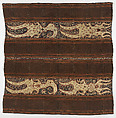Woman's Ceremonial Skirt (Tapis)
Not on view
The region of Lampung, Southern Sumatra, is located on the Sunda Strait and has been a major nexus of trade since antiquity. These histories are woven into Lampung textiles, which have developed over centuries of influence from migration and trade with mainland Asia, Europe and the Middle East. This cosmopolitanism is expressed through the diversity of weaving motifs, techniques and embellishment of Lampung textiles, as well as material expressions wealth brought through the pepper trade. The Paminggir people who live in the south of Lampung express their status and rank through the ownership, wearing and display of ceremonial textiles. Lampung textiles were valued items within trade networks and their rich maritime symbolism including trade ships and marine creatures speak to the cultural importance of sea journeys and stories of the arrival of wealth by ship. Textiles are also an embodiment of adat, a word derived from Arabic that has been adopted across Indonesia to describe a set of practices that preserve the links between ancestors and their descendants. Adat governs the protocols of how textiles are worn, and the continuation of weaving motifs that pass through many generations.
Tapis are among the most prestigious textiles from Lampung and were worn by the highest-ranking women during rites of passage such as female initiations and weddings. When worn for ceremony, the tapis was accompanied by a headdress and other forms of adornment that expressed the wealth and nobility of the woman’s family. As tapis are passed down from one generation to the next, they become revered heirlooms known as pusaka.
While this example has been opened at the seam to display its full design, tapis are assembled as a long, tubular skirt, and their designs are intended to be read on the body in the round. Tapis are characterized by woven bands of warp ikat designs that alternate with panels embroidered with silk floss or gold threads. The ikat designs of tapis are incredibly refined. Ikat is a complicated technique in which warp threads are resist-dyed to create patterns prior to the weft threads being woven across the loom. While ikat lends itself to repeating geometric designs, the embroidery and applique embellishments of tapis allow for a more fluid creative expression by the artist.
Tapis can be woven in cotton, or a mixture of cotton and silk, in polychrome or monochrome, and with a vast diversity of different motifs. The amoeboid shape of the embroidered designs in this example is known as cumi-cumi and is believed to refer to a squid or cuttlefish. While cumi-cumi is a popular design found on tapis that has been passed down through many generations, today its origins and meaning are not fully understood. It is possible that the cuttlefish’s abilities as a shapeshifter that can change its color and patterning in response to its environment is one reason for its popularity as a weaving motif.
Due to rights restrictions, this image cannot be enlarged, viewed at full screen, or downloaded.

